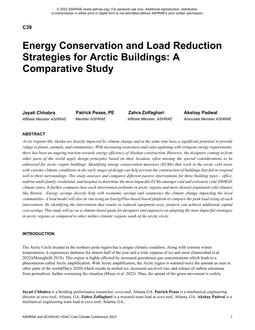
Energy Conservation and Load Reduction Strategies for Arctic Buildings: A Comparative Study
Click here to purchase
Arctic regions like Alaska are heavily impacted by climate change and at the same time have a significant potential to provide refuge to plants, animals, and communities. With increasing awareness and codes updating with stringent energy requirements, there has been an ongoing traction towards energy efficiency of Alaskan construction. However, the designers coming in from other parts of the world apply design principles based on their location, often missing the special considerations to be addressed for arctic region buildings. Identifying energy conservation measures (ECMs) that work in the arctic cold areas with extreme climatic conditions in the early stages of design can help prevent the construction of buildings that fail to respond well to their surroundings. This study assesses and compares different passive interventions for three building types – office, midrise multi-family residential, and hospital to determine the most impactful ECMs amongst cold and extremely cold ASHRAE climate zones. It further compares how each intervention performs in arctic regions and more densely populated cold climates like Boston. Energy savings directly help with economic savings and counteract the climate change impacting the local communities. A load model will also be run using an EnergyPlus-based based platform to compare the peak load sizing of each intervention. By identifying the intervention that results in reduced equipment sizes, projects can achieve additional capital cost savings. This study will act as a climate-based guide for designers and engineers on adopting the most impactful strategies in arctic regions as compared to other milder climatic regions south of the arctic circle.
Product Details
- Published:
- 2023
- Number of Pages:
- 9
- Units of Measure:
- Dual
- File Size:
- 1 file , 1.8 MB
- Product Code(s):
- D-CCC23-39
- Note:
- This product is unavailable in Russia, Belarus


